Sandareka Wickramanayake
GAL-MAD: Towards Explainable Anomaly Detection in Microservice Applications Using Graph Attention Networks
Mar 31, 2025



Abstract:The transition to microservices has revolutionized software architectures, offering enhanced scalability and modularity. However, the distributed and dynamic nature of microservices introduces complexities in ensuring system reliability, making anomaly detection crucial for maintaining performance and functionality. Anomalies stemming from network and performance issues must be swiftly identified and addressed. Existing anomaly detection techniques often rely on statistical models or machine learning methods that struggle with the high-dimensional, interdependent data inherent in microservice applications. Current techniques and available datasets predominantly focus on system traces and logs, limiting their ability to support advanced detection models. This paper addresses these gaps by introducing the RS-Anomic dataset generated using the open-source RobotShop microservice application. The dataset captures multivariate performance metrics and response times under normal and anomalous conditions, encompassing ten types of anomalies. We propose a novel anomaly detection model called Graph Attention and LSTM-based Microservice Anomaly Detection (GAL-MAD), leveraging Graph Attention and Long Short-Term Memory architectures to capture spatial and temporal dependencies in microservices. We utilize SHAP values to localize anomalous services and identify root causes to enhance explainability. Experimental results demonstrate that GAL-MAD outperforms state-of-the-art models on the RS-Anomic dataset, achieving higher accuracy and recall across varying anomaly rates. The explanations provide actionable insights into service anomalies, which benefits system administrators.
KVC-onGoing: Keystroke Verification Challenge
Dec 29, 2024



Abstract:This article presents the Keystroke Verification Challenge - onGoing (KVC-onGoing), on which researchers can easily benchmark their systems in a common platform using large-scale public databases, the Aalto University Keystroke databases, and a standard experimental protocol. The keystroke data consist of tweet-long sequences of variable transcript text from over 185,000 subjects, acquired through desktop and mobile keyboards simulating real-life conditions. The results on the evaluation set of KVC-onGoing have proved the high discriminative power of keystroke dynamics, reaching values as low as 3.33% of Equal Error Rate (EER) and 11.96% of False Non-Match Rate (FNMR) @1% False Match Rate (FMR) in the desktop scenario, and 3.61% of EER and 17.44% of FNMR @1% at FMR in the mobile scenario, significantly improving previous state-of-the-art results. Concerning demographic fairness, the analyzed scores reflect the subjects' age and gender to various extents, not negligible in a few cases. The framework runs on CodaLab.
IEEE BigData 2023 Keystroke Verification Challenge (KVC)
Jan 29, 2024Abstract:This paper describes the results of the IEEE BigData 2023 Keystroke Verification Challenge (KVC), that considers the biometric verification performance of Keystroke Dynamics (KD), captured as tweet-long sequences of variable transcript text from over 185,000 subjects. The data are obtained from two of the largest public databases of KD up to date, the Aalto Desktop and Mobile Keystroke Databases, guaranteeing a minimum amount of data per subject, age and gender annotations, absence of corrupted data, and avoiding excessively unbalanced subject distributions with respect to the considered demographic attributes. Several neural architectures were proposed by the participants, leading to global Equal Error Rates (EERs) as low as 3.33% and 3.61% achieved by the best team respectively in the desktop and mobile scenario, outperforming the current state of the art biometric verification performance for KD. Hosted on CodaLab, the KVC will be made ongoing to represent a useful tool for the research community to compare different approaches under the same experimental conditions and to deepen the knowledge of the field.
Towards Fully Interpretable Deep Neural Networks: Are We There Yet?
Jun 24, 2021


Abstract:Despite the remarkable performance, Deep Neural Networks (DNNs) behave as black-boxes hindering user trust in Artificial Intelligence (AI) systems. Research on opening black-box DNN can be broadly categorized into post-hoc methods and inherently interpretable DNNs. While many surveys have been conducted on post-hoc interpretation methods, little effort is devoted to inherently interpretable DNNs. This paper provides a review of existing methods to develop DNNs with intrinsic interpretability, with a focus on Convolutional Neural Networks (CNNs). The aim is to understand the current progress towards fully interpretable DNNs that can cater to different interpretation requirements. Finally, we identify gaps in current work and suggest potential research directions.
Learning Semantically Meaningful Features for Interpretable Classifications
Jan 11, 2021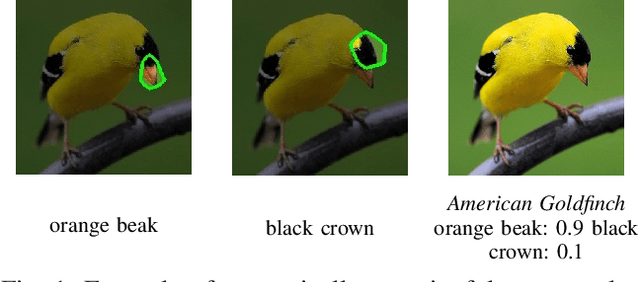
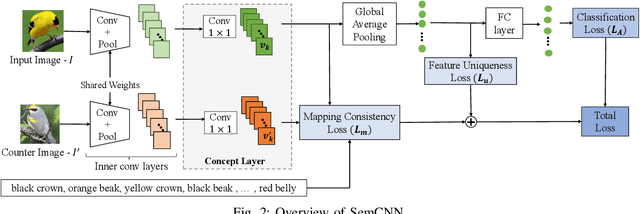
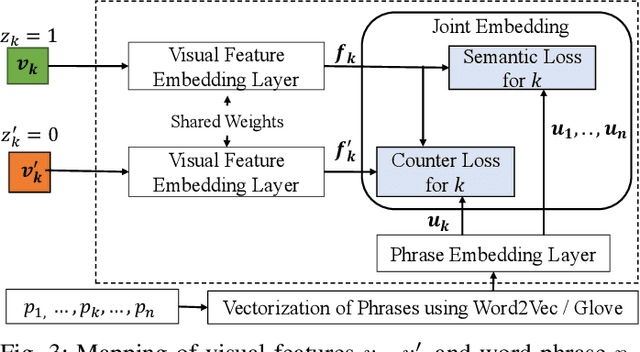

Abstract:Learning semantically meaningful features is important for Deep Neural Networks to win end-user trust. Attempts to generate post-hoc explanations fall short in gaining user confidence as they do not improve the interpretability of feature representations learned by the models. In this work, we propose Semantic Convolutional Neural Network (SemCNN) that has an additional Concept layer to learn the associations between visual features and word phrases. SemCNN employs an objective function that optimizes for both the prediction accuracy as well as the semantic meaningfulness of the learned feature representations. Further, SemCNN makes its decisions as a weighted sum of the contributions of these features leading to fully interpretable decisions. Experiment results on multiple benchmark datasets demonstrate that SemCNN can learn features with clear semantic meaning and their corresponding contributions to the model decision without compromising prediction accuracy. Furthermore, these learned concepts are transferrable and can be applied to new classes of objects that have similar concepts.
Real-Time Monitoring and Driver Feedback to Promote Fuel Efficient Driving
Jul 03, 2020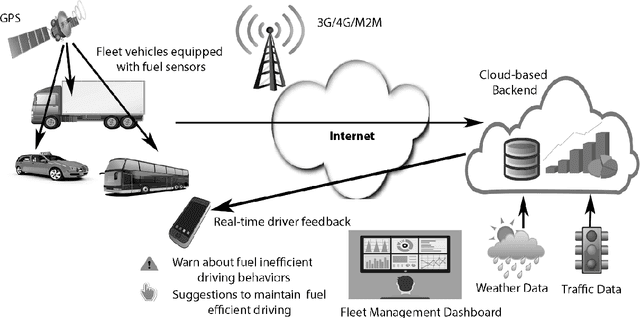

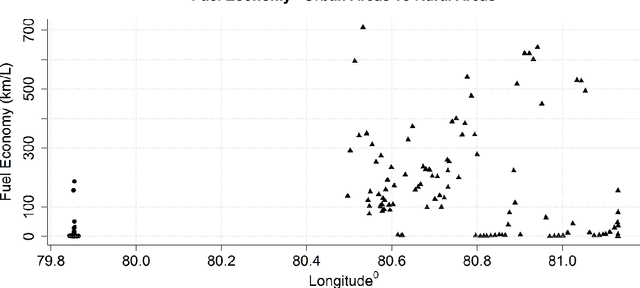
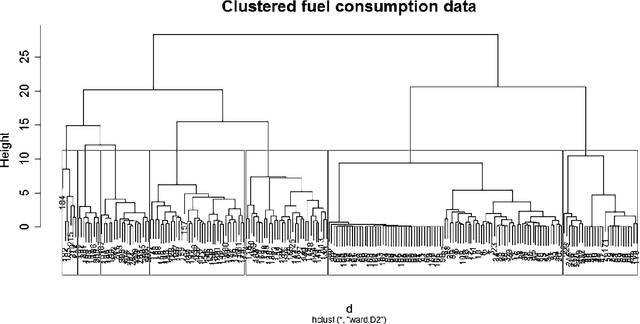
Abstract:Improving the fuel efficiency of vehicles is imperative to reduce costs and protect the environment. While the efficient engine and vehicle designs, as well as intelligent route planning, are well-known solutions to enhance the fuel efficiency, research has also demonstrated that the adoption of fuel-efficient driving behaviors could lead to further savings. In this work, we propose a novel framework to promote fuel-efficient driving behaviors through real-time automatic monitoring and driver feedback. In this framework, a random-forest based classification model developed using historical data to identifies fuel-inefficient driving behaviors. The classifier considers driver-dependent parameters such as speed and acceleration/deceleration pattern, as well as environmental parameters such as traffic, road topography, and weather to evaluate the fuel efficiency of one-minute driving events. When an inefficient driving action is detected, a fuzzy logic inference system is used to determine what the driver should do to maintain fuel-efficient driving behavior. The decided action is then conveyed to the driver via a smartphone in a non-intrusive manner. Using a dataset from a long-distance bus, we demonstrate that the proposed classification model yields an accuracy of 85.2% while increasing the fuel efficiency up to 16.4%.
 Add to Chrome
Add to Chrome Add to Firefox
Add to Firefox Add to Edge
Add to Edge